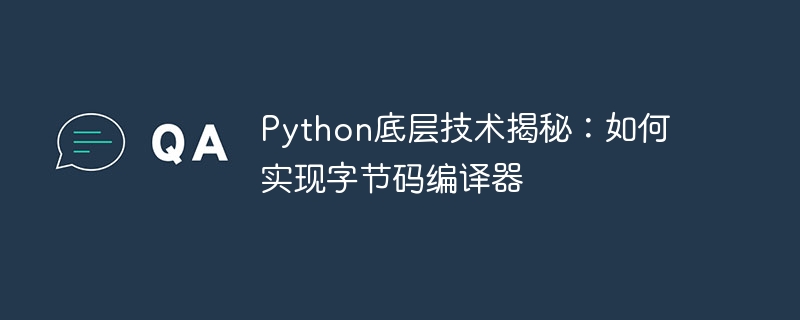

Secrets of Python’s underlying technology: How to implement a bytecode compiler
As a high-level language, Python’s powerful features and flexibility attract many developers. However, to truly understand Python in depth, we need to delve into its underlying technology and explore its inner workings. This article will take you through the secrets of Python's underlying bytecode compiler, explore its working principles in depth, and provide specific code examples.
The bytecode compiler is an important part of the Python interpreter. It is responsible for compiling Python source code into bytecode. Bytecode is a low-level, platform-independent intermediate language that allows the Python interpreter to run the same bytecode on different platforms.
The bytecode compiler converts each statement in the Python source code into one or more bytecode instructions, which are executed in the interpreter. In Python, bytecode is saved on disk via a .pyc file so that it can be reused later.
The workflow of the bytecode compiler can be roughly divided into the following steps:
1. 词法分析(Lexical Analysis):将源代码分解成一个个的标记(token),例如关键字、标识符等。 2. 语法分析(Syntax Analysis):根据源代码的语法规则构建语法树(parse tree),这个树表示了代码的结构和层次。 3. 语义分析(Semantic Analysis):分析语法树,进行类型检查和作用域分析等,为生成字节码做准备。 4. 字节码生成(Bytecode Generation):根据语义分析得到的信息,生成相应的字节码指令序列。
Below, we will demonstrate how to use Python to implement a simple bytecode compiler. We will take a simple function as an example and compile its source code into bytecode instructions.
import dis
def add_two_numbers(a, b):
return a + b
code_obj = add_two_numbers.__code__
bytecode = code_obj.co_code
print("Generated Bytecode:")
print(bytecode)
print("Disassembled Bytecode:")
dis.dis(add_two_numbers)In this example, we define a simple function add_two_numbers, then get its bytecode object code_obj and pass co_codeAttribute gets its bytecode. Finally, we use the dis function of the dis module to disassemble the function and print out the bytecode instructions of the function.
By running the above code, we can see the bytecode instructions of function add_two_numbers and its disassembly results. This shows how a bytecode compiler works and how source code is compiled into bytecode instructions.
Python's bytecode compiler is a key component of Python language implementation. Understanding its working principle is important for us to deeply understand the Python language and optimize the code. significance. This article explains the working principle of the bytecode compiler and provides a simple implementation example, hoping that readers can have a deeper understanding of Python's underlying technology. In future study and practice, you can gain a better understanding of the internal working mechanism of the Python language through an in-depth understanding of the bytecode compiler, laying a solid foundation for code optimization and performance improvement.
The above is the detailed content of Python underlying technology revealed: how to implement a bytecode compiler. For more information, please follow other related articles on the PHP Chinese website!




